Radiant Blockchain Node Network
Learn about the 3 different Radiant Node types. Mining, Agent and Archive.
Introduction
Radiant is a peer-to-peer digital asset system that enables direct exchange of value without going through a central party. The Radiant Network requires minimal structure, and timestamps transactions into an ongoing hash-based chain of Proof-of-Work (SHA512/256).
Note: All nodes are full nodes until a future update is released, which will add Archive and Agent types to the network (only around 8GB for full nodes currently)
Mining Nodes are well-connected and build on top of each other's blocks.
Agent Nodes are listener nodes which filter and store transactions to serve clients.
Archive Nodes store complete blocks for historical analysis and bootstrapping purposes.

Radiant Network
The network topology is a nearly complete graph, wherein every Mining Node is connected to every other Mining Node. The steps to run the network are the same as Bitcoin, with some distinctions for different node types: Mining Nodes, Agent Nodes, Archive Nodes.
Mining Nodes are the active publishers of blocks and maintain consensus with all other nodes, Archive Nodes serve historical block data, and Agent Nodes are designed to filter blocks and track transactions of interest to the applications they serve.
Archive and Agent Nodes may operate on the same peer-to-peer network and yet do not produce blocks. The non-Mining Nodes such as Archive and Agent Nodes are sometimes referred to as "listener nodes" to distinguish their role in the network.
Mining Nodes
Mining Nodes are well-connected into a nearly complete graph between other Mining Nodes. Their job is to build on top of each other's blocks and maintain consensus for the most recent few hundred blocks, and maintain the UTXO set for the prevention of double-spending.
Agent Nodes
Agent Nodes only need to store a subset transactions, for example, a specific coin type or digital asset. Even with large blocks, an Agent Node can quickly filter transactions by references or specific byte-sequences, then store those transactions to serve via an application programmer interface. Between cooperating agents, a Merkle Tree root hash can be publicly announced for the transactions in each block that match a pre-determined pattern to signal to other Agents and consumers which transactions that Agent has processed.
Archive Nodes
Archive Nodes are used to create backup copies of entire blocks for various applications including data warehousing, analytics and machine learning. Since Archive Nodes are not involved directly in mining, they do not have the same real-time performance and bandwidth requirements as Mining or Agent Nodes.
Radiant Whitepaper
Section '6. Network' of the Radiant Whitepaper has further information and details
Run and host a Node
Support the growth of the Radiant Network
Guide on how to set up a Radiant Node
Alternate method: Setup a node with Docker
Join the Radiant Discord and ask how you can help in the #node-help channel
What is a Full Node and an ElectrumX Server?
Discover the key differences and why hosting an ElectrumX Server on Radiant is also vital for network resilience and user experience.
Full Node
Role: A Full Node in the Radiant Network, like in other blockchains, is responsible for maintaining a complete copy of the blockchain and validating all transactions and blocks independently. Full Nodes participate directly in the network consensus, ensuring the blockchain's integrity.
Data Storage: They store the entire blockchain history, including all blocks and transactions, which allows them to serve as a source of truth for the network.
Use Cases: Full Nodes are crucial for those who want to fully validate all network data themselves, without relying on third parties. This makes them essential for maintaining network decentralization and security.
ElectrumX Server
Role: An ElectrumX Server serves a different purpose. It acts as a specialized server for lightweight wallets, like the Electronwallet, enabling users to query blockchain data without needing to download and maintain the entire blockchain themselves.
Data Storage: Unlike Full Nodes, ElectrumX Servers index blockchain data in a way that allows fast queries about balances, transactions, and block information. They do not store the entire blockchain but rather create a searchable database to quickly respond to wallet requests.
Use Cases: ElectrumX Servers are ideal for those looking to support wallet users who need quick access to their transaction history and balances without running a Full Node. By contributing an ElectrumX Server, you enhance the network by increasing redundancy and improving the speed and reliability of wallet services.
See the publicly available Radiant ElectrumX Servers' Statuses.
Run a public Radiant ElectrumX Server to support the Network and Community.
Read through this Radiant Server Setup Guide on how to setup and run a Radiant Node and ElectrumX Server.
Why Contribute an ElectrumX Server to Radiant?
- Redundancy: More ElectrumX Servers mean more backup points for wallet users, ensuring that even if one server fails, others can take over, leading to a more resilient network.
- Speed: Increased server availability can significantly reduce the time it takes for users to get their transaction data, improving overall user experience.
- Community Support: By running an ElectrumX Server, you directly contribute to the decentralization and robustness of the Radiant ecosystem, helping the network grow and thrive.
Running an ElectrumX Server is less resource-intensive than a Full Node and directly benefits the user experience by providing faster access to blockchain data, making it a great way to support the network.